Abstract
The in vitro activities of seven fluoroquinolones against 290 anaerobes were determined by agar dilution. CI-960 and WIN 57273 inhibited greater than 95% of the strains at less than or equal to 2 micrograms/ml. CI-990 required less than or equal to 16 micrograms/ml. Clustering around 2 to 4 micrograms/ml was noted for Bacteroides fragilis group organisms with CI-990, sparfloxacin, and temafloxacin. Temafloxacin and sparfloxacin inhibited most strains at less than or equal to 2 micrograms/ml. B. fragilis was more susceptible to all quinolones than were the other B. fragilis group strains.
Full text
PDF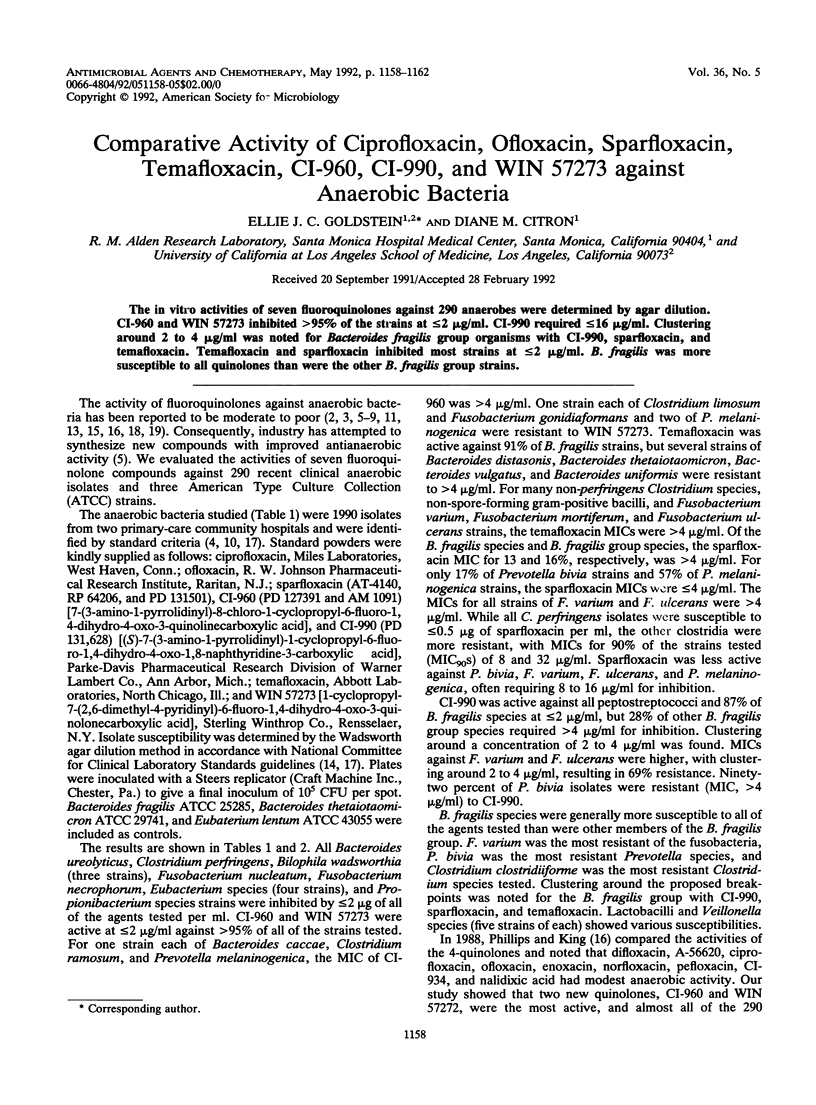
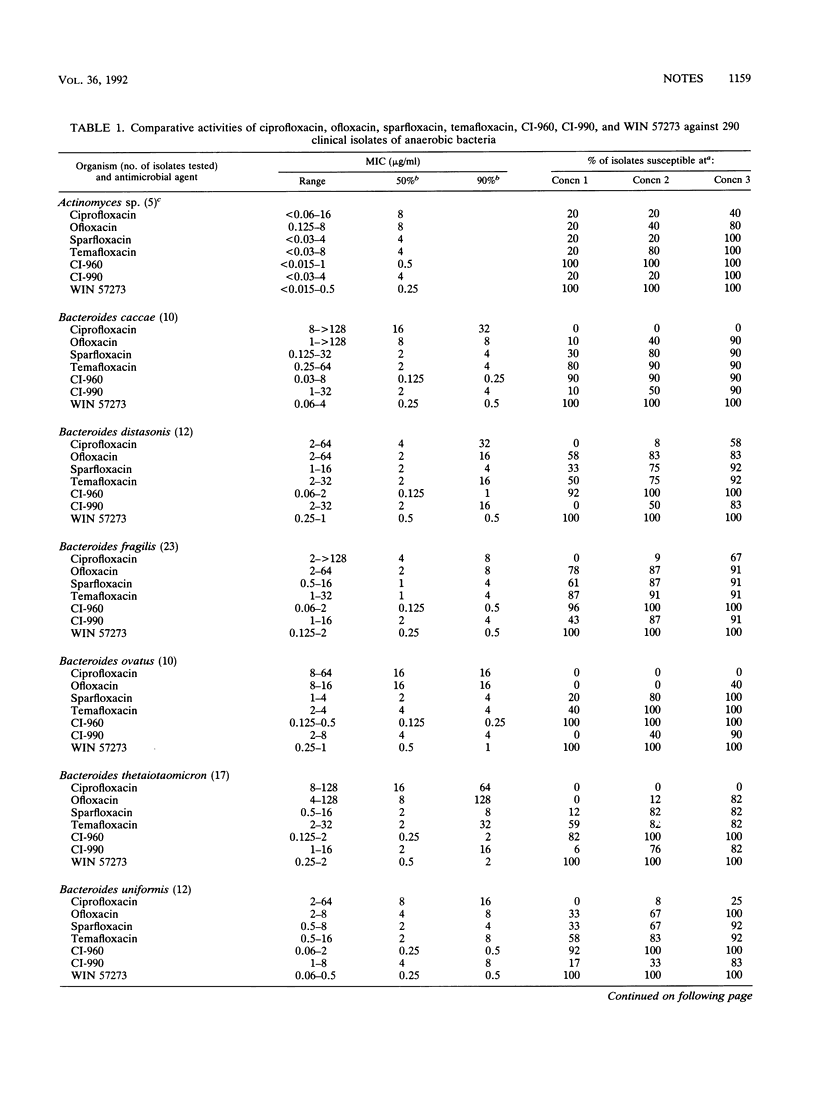
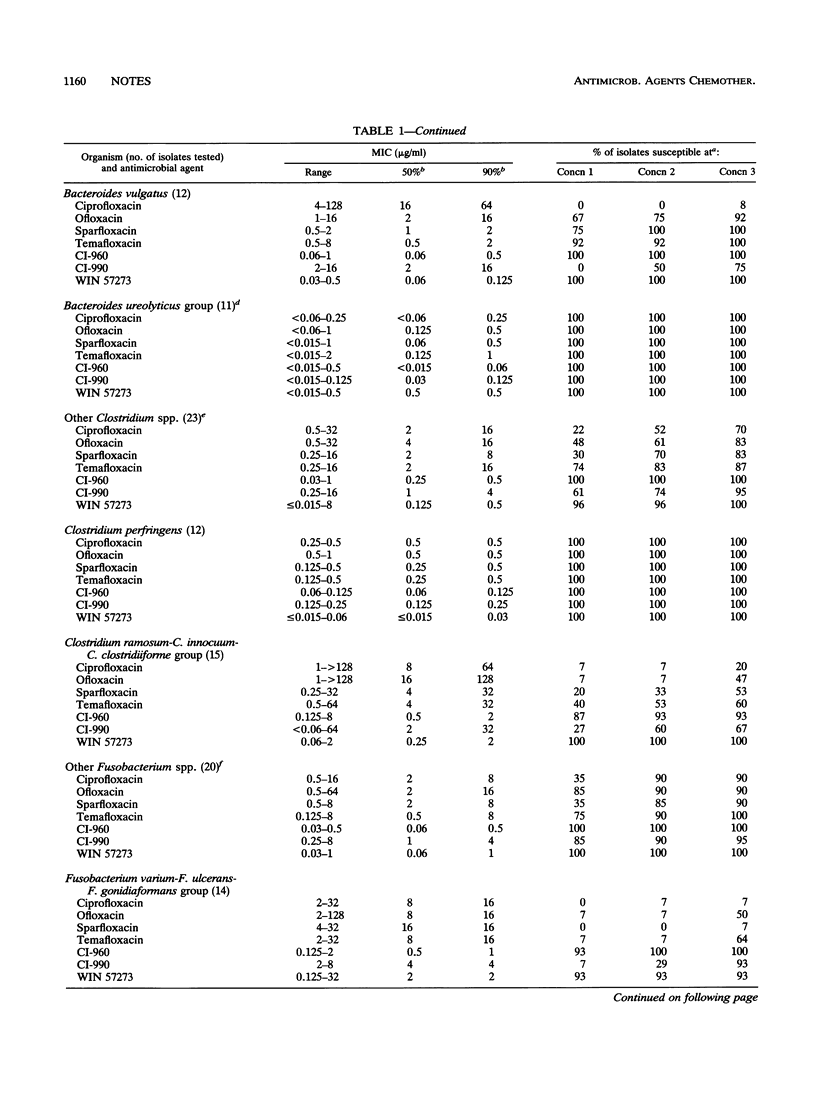
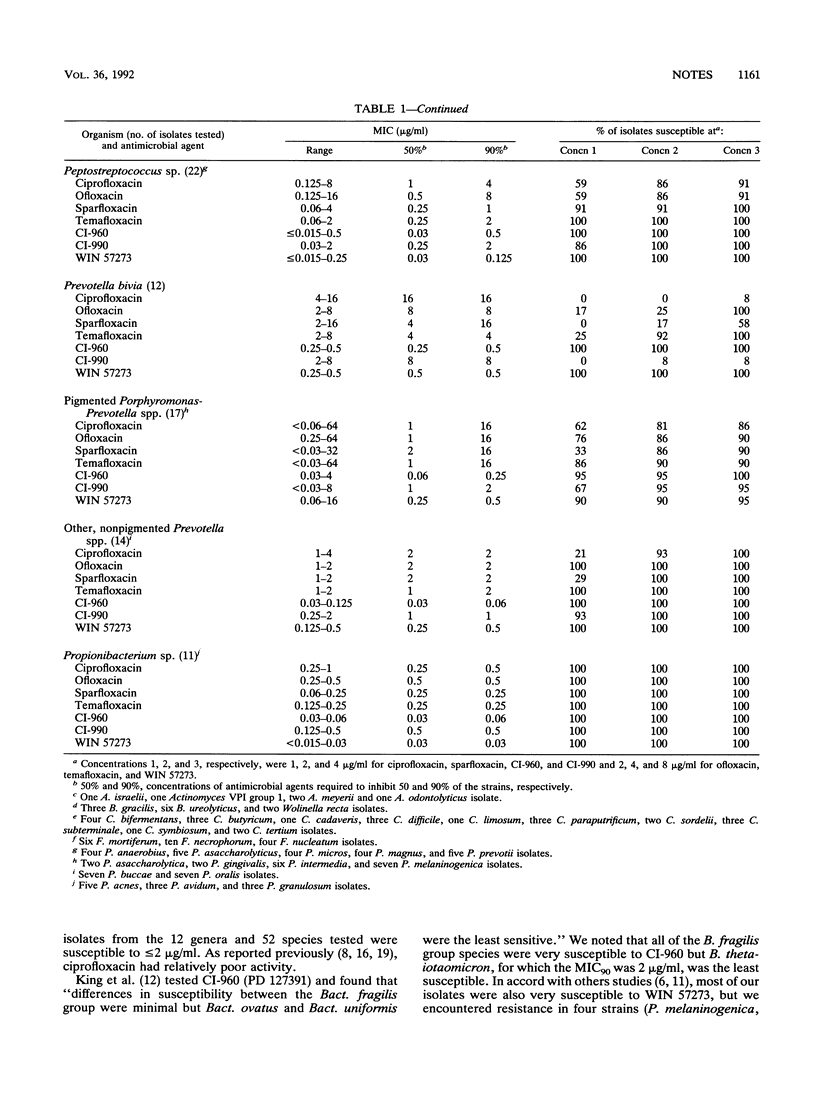
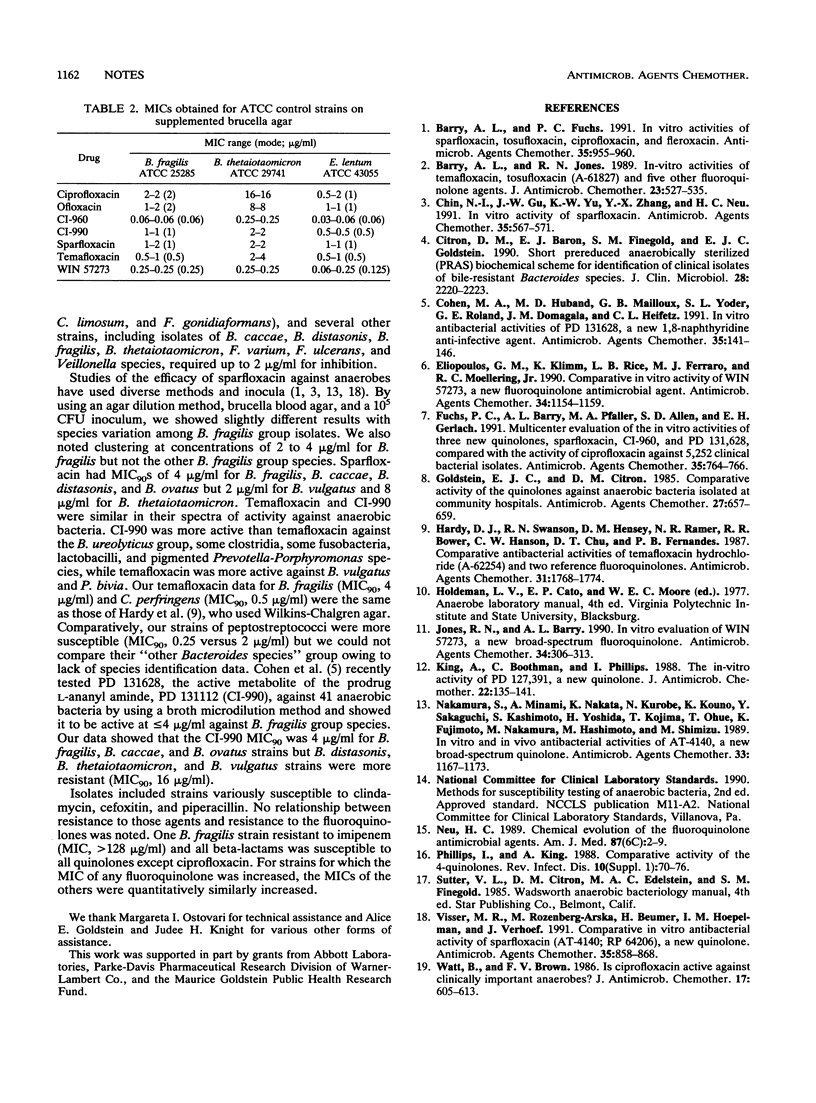
Selected References
These references are in PubMed. This may not be the complete list of references from this article.
- Barry A. L., Fuchs P. C. In vitro activities of sparfloxacin, tosufloxacin, ciprofloxacin, and fleroxacin. Antimicrob Agents Chemother. 1991 May;35(5):955–960. doi: 10.1128/aac.35.5.955. [DOI] [PMC free article] [PubMed] [Google Scholar]
- Barry A. L., Jones R. N. In-vitro activities of temafloxacin, tosufloxacin (A-61827) and five other fluoroquinolone agents. J Antimicrob Chemother. 1989 Apr;23(4):527–535. doi: 10.1093/jac/23.4.527. [DOI] [PubMed] [Google Scholar]
- Chin N. X., Gu J. W., Yu K. W., Zhang Y. X., Neu H. C. In vitro activity of sparfloxacin. Antimicrob Agents Chemother. 1991 Mar;35(3):567–571. doi: 10.1128/aac.35.3.567. [DOI] [PMC free article] [PubMed] [Google Scholar]
- Citron D. M., Baron E. J., Finegold S. M., Goldstein E. J. Short prereduced anaerobically sterilized (PRAS) biochemical scheme for identification of clinical isolates of bile-resistant Bacteroides species. J Clin Microbiol. 1990 Oct;28(10):2220–2223. doi: 10.1128/jcm.28.10.2220-2223.1990. [DOI] [PMC free article] [PubMed] [Google Scholar]
- Cohen M. A., Huband M. D., Mailloux G. B., Yoder S. L., Roland G. E., Domagala J. M., Heifetz C. L. In vitro antibacterial activities of PD 131628, a new 1,8-naphthyridine anti-infective agent. Antimicrob Agents Chemother. 1991 Jan;35(1):141–146. doi: 10.1128/aac.35.1.141. [DOI] [PMC free article] [PubMed] [Google Scholar]
- Eliopoulos G. M., Klimm K., Rice L. B., Ferraro M. J., Moellering R. C., Jr Comparative in vitro activity of WIN 57273, a new fluoroquinolone antimicrobial agent. Antimicrob Agents Chemother. 1990 Jun;34(6):1154–1159. doi: 10.1128/aac.34.6.1154. [DOI] [PMC free article] [PubMed] [Google Scholar]
- Fuchs P. C., Barry A. L., Pfaller M. A., Allen S. D., Gerlach E. H. Multicenter evaluation of the in vitro activities of three new quinolones, sparfloxacin, CI-960, and PD 131,628, compared with the activity of ciprofloxacin against 5,252 clinical bacterial isolates. Antimicrob Agents Chemother. 1991 Apr;35(4):764–766. doi: 10.1128/aac.35.4.764. [DOI] [PMC free article] [PubMed] [Google Scholar]
- Goldstein E. J., Citron D. M. Comparative activity of the quinolones against anaerobic bacteria isolated at community hospitals. Antimicrob Agents Chemother. 1985 Apr;27(4):657–659. doi: 10.1128/aac.27.4.657. [DOI] [PMC free article] [PubMed] [Google Scholar]
- Hardy D. J., Swanson R. N., Hensey D. M., Ramer N. R., Bower R. R., Hanson C. W., Chu D. T., Fernandes P. B. Comparative antibacterial activities of temafloxacin hydrochloride (A-62254) and two reference fluoroquinolones. Antimicrob Agents Chemother. 1987 Nov;31(11):1768–1774. doi: 10.1128/aac.31.11.1768. [DOI] [PMC free article] [PubMed] [Google Scholar]
- Jones R. N., Barry A. L. In vitro evaluation of WIN 57273, a new broad-spectrum fluoroquinolone. Antimicrob Agents Chemother. 1990 Feb;34(2):306–313. doi: 10.1128/aac.34.2.306. [DOI] [PMC free article] [PubMed] [Google Scholar]
- King A., Boothman C., Phillips I. The in-vitro activity of PD127,391, a new quinolone. J Antimicrob Chemother. 1988 Aug;22(2):135–141. doi: 10.1093/jac/22.2.135. [DOI] [PubMed] [Google Scholar]
- Nakamura S., Minami A., Nakata K., Kurobe N., Kouno K., Sakaguchi Y., Kashimoto S., Yoshida H., Kojima T., Ohue T. In vitro and in vivo antibacterial activities of AT-4140, a new broad-spectrum quinolone. Antimicrob Agents Chemother. 1989 Aug;33(8):1167–1173. doi: 10.1128/aac.33.8.1167. [DOI] [PMC free article] [PubMed] [Google Scholar]
- Sherman R. A. Central catheter infection: single-versus triple-lumen catheters. Am J Med. 1989 Jul;87(1):2–3. doi: 10.1016/s0002-9343(89)80469-3. [DOI] [PubMed] [Google Scholar]
- Visser M. R., Rozenberg-Arska M., Beumer H., Hoepelman I. M., Verhoef J. Comparative in vitro antibacterial activity of sparfloxacin (AT-4140; RP 64206), a new quinolone. Antimicrob Agents Chemother. 1991 May;35(5):858–868. doi: 10.1128/aac.35.5.858. [DOI] [PMC free article] [PubMed] [Google Scholar]
- Watt B., Brown F. V. Is ciprofloxacin active against clinically important anaerobes? J Antimicrob Chemother. 1986 May;17(5):605–613. doi: 10.1093/jac/17.5.605. [DOI] [PubMed] [Google Scholar]


